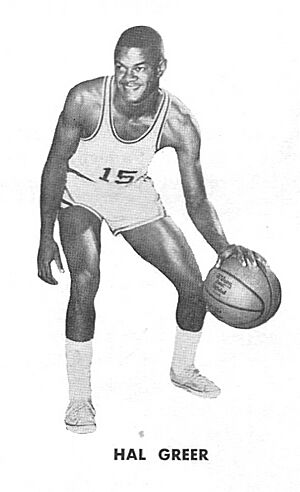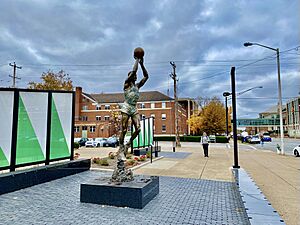Hal Greer facts for kids

Greer in 1969
|
|
| Personal information | |
|---|---|
| Born | June 26, 1936 Huntington, West Virginia, U.S. |
| Nationality | American |
| Died | April 14, 2018 (aged 81) Arizona, U.S. |
| High school | Douglass (Huntington, West Virginia) |
| Listed height | 6 ft 2 in (1.88 m) |
| Listed weight | 175 lb (79 kg) |
| Career information | |
| College | Marshall (1955–1958) |
| NBA Draft | 1958 / Round: 2 / Pick: 13th overall |
| Selected by the Syracuse Nationals | |
| Pro career | 1958–1973 |
| Career history | |
| 1958–1973 | Syracuse Nationals / Philadelphia 76ers |
| Career highlights and awards | |
|
|
| Career statistics | |
| Points | 21,586 (19.2 ppg) |
| Rebounds | 5,665 (5.0 rpg) |
| Assists | 4,540 (4.0 apg) |
Harold Everett Greer (born June 26, 1936 – died April 14, 2018) was a famous American professional basketball player. He played as a guard for the Syracuse Nationals and Philadelphia 76ers in the National Basketball Association (NBA). His career lasted from 1958 to 1973.
Greer was an amazing player, chosen for the NBA All-Star team 10 times. He was also named to the All-NBA Second Team seven times. He is considered one of the greatest players ever, being named to the 50 Greatest Players in NBA History and the NBA 75th Anniversary Team. His jersey number, 15, was retired by the Philadelphia 76ers. Hal Greer is also a member of the Basketball Hall of Fame.
Contents
Early Life and College Career
Hal Greer was born in Huntington, West Virginia. He went to Douglass Junior and Senior High School, which was an all-black school at the time. He played basketball there as a guard.
After high school, Greer went to Marshall University. He played college basketball for the Marshall Thundering Herd team. He was the first African American to play for a public college in West Virginia.
While at Marshall, Greer scored 1,377 points. This was a record for the school at the time. In 1956, Marshall won the Mid-American Conference championship. They also made their first appearance in the NCAA men's basketball tournament. Greer was named All-Mid-American Conference in both 1957 and 1958. He was also named an All-American in 1958. Greer averaged 19.4 points per game and 10.8 rebounds per game during his college career. In his final year, he averaged 23.6 points per game. He even played for the school's baseball team for one year.
NBA Career Highlights
The Syracuse Nationals picked Hal Greer as the 13th player in the 1958 NBA draft. He played for Syracuse for five seasons. His scoring average grew to 22.8 points per game in 1961. That same year, he was chosen for the NBA All-Star team.
In 1963, the Syracuse Nationals team moved to Philadelphia. They became the Philadelphia 76ers. There, Greer played with the legendary Wilt Chamberlain. Together, they helped the 76ers win the NBA championship in the 1966–67 season. In the 15 playoff games that season, Greer led his team in scoring. He averaged 27.7 points per game.
Greer had a special way of shooting free throws. He would shoot a jump shot from the free throw line. This was very unusual but worked well for him. Many people think he was the third-best guard of the 1960s. Only Oscar Robertson and Jerry West were considered better.
Greer played in 10 NBA All-Star Games. He was named the MVP (Most Valuable Player) of the 1968 game. In that game, he made all 8 of his shots. He scored 21 points, with a record-breaking 19 points in just one quarter. He was also chosen for the All-NBA Second Team seven times. He scored a total of 21,586 points in his NBA career. When he retired in 1973, he had played more games than any other player in NBA history. He was also in the top ten for points scored and shots made. At the time of his death, Greer still held many team records for the 76ers. These included points scored, shots made, games played, and minutes played.
Life After Playing Basketball
After his playing career, Hal Greer became a coach. In 1980, he coached the Philadelphia Kings. This team was part of the Continental Basketball League. He also coached the basketball team at Germantown Academy in Pennsylvania.
Legacy and Honors
Hal Greer's hometown of Huntington, West Virginia, has honored him many times. They held a "Hal Greer Day" in 1966. In 1978, they renamed 16th Street to "Hal Greer Boulevard." This street is a main road in his hometown.
The 76ers retired Greer's jersey number, No. 15, in 1976. He was the very first player the 76ers honored in this way. Marshall University also retired his college jersey number, No. 16. Marshall University put Greer into its Athletics Hall of Fame in 1985. This was for his great careers in both basketball and baseball.
In 1982, Greer was inducted into the Naismith Memorial Basketball Hall of Fame. He was one of the first African-American athletes from West Virginia to be in a major sports hall of fame. In 1996, he was named one of the 50 Greatest Players in NBA History. The 76ers put up a statue of Greer at their training center in 2017.
In 2021, Marshall University honored Greer with a bronze statue. It looks just like him and was placed near the arena where Marshall plays basketball. Two weeks later, he was named to the NBA 75th Anniversary Team.
Achievements and Awards
- Led the 76ers to an NBA Championship in 1967, averaging 22 points per game.
- Played in 10 straight NBA All-Star Games from 1961 to 1970.
- Was the NBA All-Star Game MVP in 1968.
- Set a record for most points scored in one quarter (19) during an All-Star Game in 1968.
- Was named to the All-NBA Second Team seven times (1963–1969).
- Scored 21,586 career points, including 50 points in one game against the Boston Celtics.
- Scored 1,876 points in 92 playoff games and 120 points in 10 All-Star Games.
- His jerseys were retired by Marshall University (#16) and the Philadelphia 76ers (#15).
Personal Life
Hal Greer and his wife, Mayme, had three children: a son and two daughters. Greer passed away on April 14, 2018, after a short illness. The 76ers announced his death and honored him before a playoff game. For the rest of those playoffs, the Sixers wore a black armband with a small number 15 patch on their jerseys.
Images for kids
See also
 In Spanish: Hal Greer para niños
In Spanish: Hal Greer para niños






